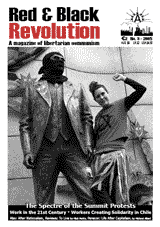Over 30 years of anarchist writing from Ireland listed under hundreds of topics
Book Review: Parecon: Life After Capitalism
Anarchists, in common with all radical proponents of social change are continually asked what their vision of a new society/economy is. What is the "Master Plan", the "Blueprint" that will be followed? We are justifiably wary of outlining any "Blueprint" for an anarchist society that would suggest that it is THE solution and should be followed to the letter - who would enforce this great master plan after all!?Any set of theoretical ideas about a new society and economy is only a model and we should all remain flexible in any approaches to its implementation. All of us together will ultimately decide co-operatively on which elements are worthy, which need to modified, and which may be discarded.
This book was written by Michael Albert who helped to found Z Magazine and South End Press. Z Magazine is an excellent progressive political magazine in the U.S. and is also published in an e-mail newsletter format, which I highly recommend.
The book outlines a radical vision of social and economic reconstruction whose core principles and values, Solidarity, Equity, Diversity and Self-Management, are very familiar to anarchists. A quick glance at the table of titles referenced shows up such titles as: Daniel Guerin's - "Anarchism", Kropotkin's - "Mutual Aid", and Rudolf Rockers "Anarcho-Syndicalism". Indeed as will be quickly discovered, the entire vision is built on well-known anarchist values.
What is interesting though, is that the word "Anarchism" does not appear anywhere in the main text, and will only be discovered if you look through the short bibliography at the very end. Was Albert trying to hide what he saw as a "dirty secret" here? I admit this is just a conjecture, but it seems hardly accidental that a book so firmly founded on anarchist principles should so carefully avoid mention of the word anarchism anywhere in the text.
The book is subdivided into 4 parts, part 1 contains an introduction to some basic economic terms and definitions - ownership, allocation, division of labour, remuneration, decision making and class structure. There follows an analysis of economic systems and how they match up to the goals of Parecon : (1) Equity, (2) Self-Management (3) Diversity (4) Solidarity and (5) Efficiency.
Capitalism and Centrally Planned "Socialism" are thoroughly picked apart here and Albert shows how each system will undermine each of the anarchist values I mentioned: Solidarity, Equity, Diversity and Self-Management.
Part 2 contains a comprehensive vision of participatory economics that outlines in some detail the economic structures that are being proposed. We can summarise the core Parecon elements as:
(1) Social ownership of the means of production
(2) Direct democratic councils (Workers and Consumers)
(3) Balanced job complexes
(4) Remuneration based solely on effort and sacrifice
(5) Allocation through participatory planning
It would be impossible to cover these in any real depth here, but suffice it to say that these economic structures do a very good job of describing how one type of anarchist economy might function in practice. A key difference between Parecon and an Anarcho-Communist economy is the continued existence of a form of "money", which some might instinctively balk at, with the implication that some form of "market" economy will continue to exist in Parecon. However I believe this fear is quite unfounded.
The fundamental allocative structure of anarcho-communism, "of each according to his need" is also fundamental to Parecon. Any extra remuneration received by individuals will be due to their own personal effort or sacrifice. To clarify, if someone works in more difficult or dangerous conditions than average, or puts in more hours of work than average, they would be remunerated for this. On the other hand, there is no remuneration for "contribution to output" - e.g. a stronger worker may cut more sugar cane in a days work than a smaller, weaker worker, but they are not paid any differently (at least on the basis of their output).
There is also social ownership of the means of production and participatory planning, organised in a federative and co-operative structure throughout all industries, so there is no "market" system as such. One of the key things to keep in mind is that prices in a parecon are generated and modified through participatory planning, starting off annually as merely "indicative", and consequently passing through several rounds of adjustment. In these pricing adjustment phases, changing productive capacity and demand is taken into account in addition to any arising social or environmental concerns.
Overall, I believe Parecon provides a comprehensive vision that is worthy of serious consideration and debate among those who are interested in more progressive economic structures. For those looking for practical examples, some of the economic structures of Parecon have been implemented on a small scale in South End Press, a publishing co-operative, which Michael Albert helped to set-up.
The entire book: Parecon "Life After Capitalism" is online
- The Verso website
- The Parecon website
-
The South End Press website
This article is from Red and Black Revolution 9, published Summer 2005


